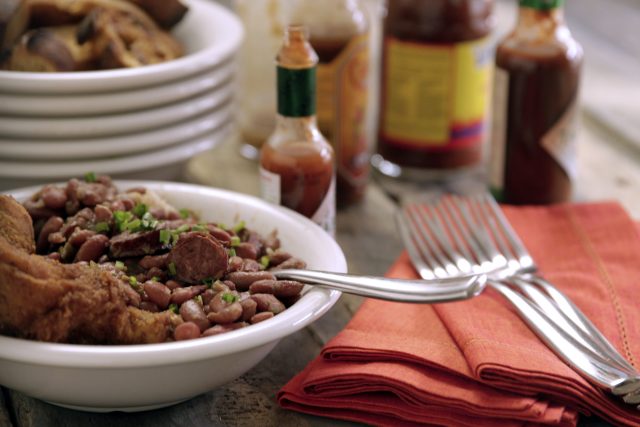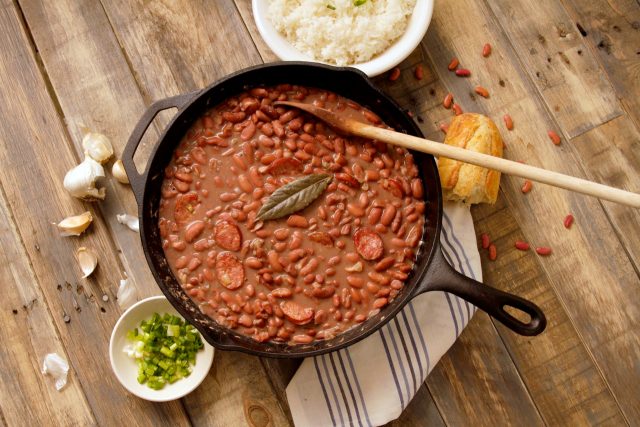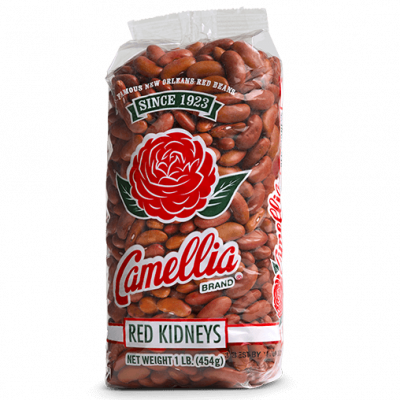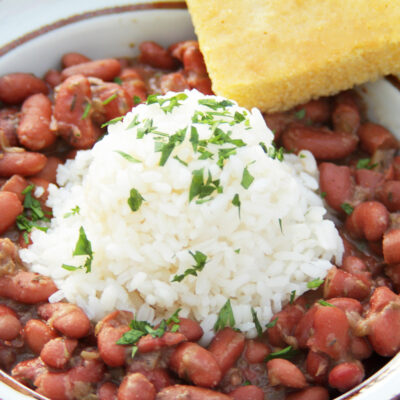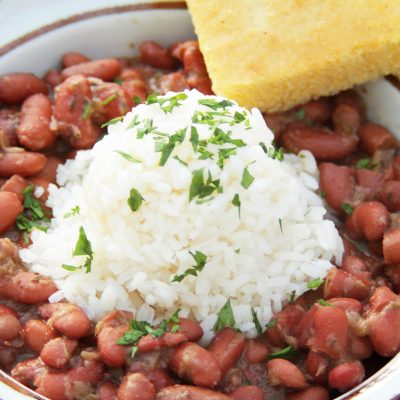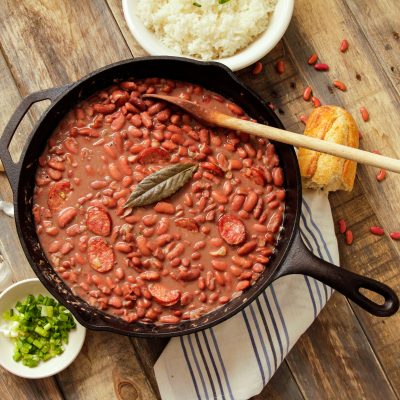A Tale of Red Beans & Rice
New Orleans is a Red Bean City
When a young Paul Prudhomme moved to New Orleans to take a sous chef position at the Le Pavillon Hotel in 1970, the city’s obsession with red kidney beans came as a shock. Though a native Louisianian, he grew up thinking red kidneys were, in his words, “just another dried bean, like pinto beans and lima beans.” But according to Susan Tucker’s New Orleans Cuisine, he soon discovered that red beans were “a cultural phenomenon, a tradition dating back for hundreds of years.”
Red kidney beans are as ubiquitous a symbol of New Orleans as the fleur-de-lis, a rite as common as Carnival. The city’s culinary connection to the lowly red bean is mighty, stretching over centuries, across distant cultures and peoples around the globe. The bean is so symbolic of the city that a newcomer, or culinary dilettante, could be fooled into thinking that the red kidney bean was native to Louisiana, which it is of course not. But, still, “this is a red bean city here”, the famed fried chicken and bean cook Willie Mae Seaton of her eponymous Scotch House was quoted as saying. In Sara Roahen’s Gumbo Tales, she said, “That’s it. If you don’t have no red beans you just out.”
“A Favorite Dish Among Creole Families”
No one knows for sure why and how New Orleanians began to eat red beans and rice. “Red beans are to New Orleans what the white bean is to Boston and the cowpea is to South Carolina,” reporters for the Federal Writers Project wrote in 1938. No definite answers exist in the historical record, though it probably travelled over with early nineteenth-century exiles from the French Caribbean.
The dish appears in cookbooks around the turn of the century, with The Picayune’s Creole Cook Book, one of the first locally published recipe books, being one of the first to include instructions on how to cook a pot of kidney beans.

“Red Beans are a favorite dish among Creole families,” the book discloses in a chapter heading containing seven different red bean recipes (including one for red or white bean polenta!). “The great amount of sustenance to be found in this and the White Bean commending it especially as a food for growing children and adults who labor hard. The beautiful color and excellent flavor of the Red Bean has won for it a place among the most highly esteemed legumes.” A recipe for Red Beans, Plain Boiled suggests that “this is an excellent way of preparing red beans for Fridays and fast days.” The recipe for Purée of Red Beans ends with a mention that “thus prepared, red beans may be eaten by the most delicate invalid with excellent results as to recuperation.” Bacon and Beans à la Créole reveals that “this is a favorite dish with the little Creole children, and is most wholesome and palatable.”
Mondays Were Red Bean Days
Monday is the day most often associated with the dish because, as the well-trod story goes, the first day of the week was washing day, and the woman responsible for providing a household with a clean set of clothes was also obligated to feed the household that evening. Cleaning and cooking left little time and attention for both, so a pot of red beans was left on the stove, simmering long and gentle throughout the day.
It’s a good tale, with perhaps some truth and historical value to it. But we can also look to other cultures, other histories, for similar tales linking a specific day with a long-simmered pot of beans.
Sabbath and Sundays Were Bean Days, Too
Hamin, sometimes called cholent or, in Spain, adafina, is a food of the Jewish diaspora. Traditionally this fava bean stew is prepared on the Sabbath, simmering for hours because no work could be done and no fires lit on this day of rest. Heinrich Heine, a intellectual heavyweight of 19th century Germany, described cholent as “the very Food of heaven, which on Sinai, God Himself instructed Moses In the secret of preparing.”
Similarly, as one theory goes, the origin of Boston Baked Beans can be traced back to the pilgrims, who adopted the practice of simmering beans in salt pork and some sort of sugar for hours from the local First Peoples. The preparation of this one-pot dish appealed to the Pilgrims because it allowed them to start the cooking on Saturday night, so as to have food to feed the family, while not having to work to do so, on the Sabbath.
Sunday’s Hambone Made Monday’s Red Beans
The other theory is that we eat red beans on Monday to reuse, or perhaps upcycle, the hambone left over from Sunday’ s dinner. Little to no historical evidence proves this theory, though Peter Feibleman, a New York-born writer raised in New Orleans, gives it a good try in American Cooking: Creole and Acadian: “a ham bone is considered the whole point of the ham. Without it, you could hardly live through Monday, for on that day, as everyone knows, you need it to get a lyrical taste into what sounds at first like the drabbest of local recipes — the classic Monday dish of red beans and rice. The secret is known to you though if you’ve sat as a child in a New Orleans kitchen on a Monday and seen the cook either crack the ham bone or make sure that one end of it is open. . . . If it is, the thick marrow from the bone leaks into the simmering beans, coats them, cooks slowly with them, seems to drain them of starch and produces a silky food that is more like incredibly tender meat that like a vegetable.”
New Orleanians like Feibleman, both born and adopted, have tried their best to put into words exactly why they cherish a bowlful of Monday red beans and rice. John Churchill Chase, the beloved New Orleans cartoonist and reporter, recorded a song local children used to sing while jumping rope: Red Beans and Rice, quartée red beans, quartée rice, little piece of salt meat to make it taste nice, lend me the paper and tell me the time, when papa passes by he’ll pay you the dime.
Louis Armstrong’s Favorite Dish
New Orleans’ s favorite son, Louis Armstrong, would often famously sign letters and autographs with, “Am red beans and ricely yours, Louis.” In his memoir Satchmo, Armstrong writes of learning to cook red beans and rice at a young age. His sister, whom he called Mama Lucy, cooked courtbouillon, creole gumbo, cabbage and rice, jambalaya, but his favorite dish of hers was red beans and rice. While courting his fourth wife, the Bronx-born Lucille Wilson, the then immensely famous, and wealthy, trumpeter asked, “ Can you cook red beans and rice?” She learned, and they were remained married until his passing. “As for red beans and rice, well, I don’t have to say anything about that,” Armstrong wrote. “It is my birth mark.”
The Bean Ratings

Gene Bourg, former restaurant critic for the Times-Picayune, of course wrote about red beans, but it was a simple act that symbolized his, and his city’s, love for the bean. In 1985 he chose red beans over stars, the New York Times oft-repeated symbol, to rate, one through five, the city’ s burgeoning restaurant scene. The bean rating is still used today.
Buster Holmes, The King of Red Beans and Rice

Buster Holmes, the dearly departed chef and proprietor of a restaurant of the same name, was perhaps the greatest red beans cook that ever stirred a pot. According to writer Jeff Hannusch’s article titled “Red Beans and Rice” in New Orleans Magazine (March 1984), Holmes said of the dish: “I can see it only getting more and more popular. I cooked beans and rice for chefs and people all over Europe, and they couldn’t get enough of them. . . . New Orleans has always been a red bean town, and as far as I can see it always will be.”
The last word will go to someone not associated with New Orleans, Michael Franti, a California-born musician and poet who with his band Spearhead wrote the most loving ode to New Orleans’ s unofficial official dish. From a verse and chorus of their song “Red Beans and Rice”: Most people on the planet eat beans and rice. Some can’t afford beef or they think cows are nice. Red beans and rice, red beans and rice, red beans and rice, Make everything nice Red beans and rice, red beans and rice, red beans and rice I could eat a plate twice. So nice. So nice. So nice.
Rien Fertel is a Louisiana-born and based food writer, historian, and teacher. He grew up in his family’s chain of restaurants across the country. His work has appeared in Oxford American, Garden & Gun, Southern Living, Spirit, Saveur, The Local Palate, and many other publications. He holds a PhD in History and teaches in New Orleans.
